#SAP data management and analytics
Explore tagged Tumblr posts
Text
youtube
#SAP Data Warehouse Cloud#SAP DWC#SAP cloud data warehouse#SAP data management and analytics#SAP data warehouse solution#Youtube
1 note
·
View note
Text
Manufacturing ERP: The Top 10 ERP Systems for 2024
Introduction:
In the dynamic landscape of the manufacturing industry, the right technology can make all the difference in streamlining processes and enhancing overall efficiency. Manufacturing Enterprise Resource Planning (ERP) systems have become indispensable tools for businesses seeking to integrate various facets of their operations seamlessly. As we step into 2024, the demand for robust ERP solutions continues to grow. In this blog, we will explore the top 10 Manufacturing ERP systems that are poised to make a significant impact on the industry this year.
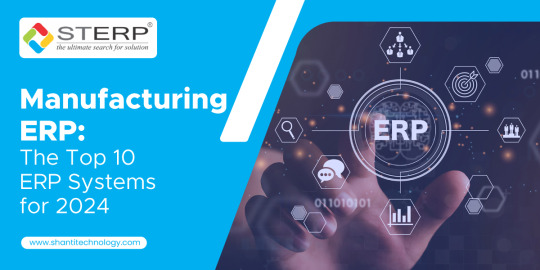
1. SAP S/4HANA: Pioneering Manufacturing Resource Planning System
One of the most trusted names in ERP, SAP S/4HANA stands out as a comprehensive Manufacturing Resource Planning System. Its real-time analytics, integrated modules, and intelligent automation make it an ideal choice for businesses aiming to optimize their manufacturing processes.
2. Oracle ERP Cloud: Empowering Manufacturing Enterprise Resource Planning
Oracle ERP Cloud offers a scalable and flexible solution for manufacturing enterprises. With its robust features, it caters to the diverse needs of businesses, ensuring a seamless integration of manufacturing operations. Its cloud-based architecture provides the agility required for modern manufacturing environments.
3. Microsoft Dynamics 365: A Versatile ERP Solution
Microsoft Dynamics 365 is gaining prominence as a Manufacturing Enterprise Resource Planning software that offers versatility and integration capabilities. Its user-friendly interface and interoperability with other Microsoft products make it an attractive choice for businesses, especially small enterprises.
4. Infor CloudSuite Industrial: Tailored Manufacturing ERP
Infor CloudSuite Industrial is designed with the unique needs of manufacturers in mind. It provides specialized functionalities, including supply chain management and shop floor control, making it a standout choice among ERP solution providers.
5. NetSuite ERP: Unifying Manufacturing Operations
NetSuite ERP is recognized for its ability to unify diverse manufacturing operations into a single, cohesive system. Its cloud-based platform allows for real-time collaboration and data accessibility, making it an efficient Manufacturing Enterprise Resource Planning Software.
6. Epicor ERP: Driving Growth for Small Businesses
Epicor ERP is particularly well-suited for small businesses in the manufacturing sector. With its focus on driving growth and improving efficiency, Epicor ERP offers a cost-effective solution without compromising on essential features.
7. IFS Applications: Comprehensive ERP Solution
IFS Applications is a comprehensive ERP solution that covers a wide range of manufacturing processes. Its modular structure allows businesses to tailor the system according to their specific requirements, making it a preferred choice for Manufacturing Enterprise Resource Planning.
8. IQMS Manufacturing ERP: Enhancing Shop Floor Control
IQMS Manufacturing ERP is distinguished by its emphasis on shop floor control and real-time monitoring. It empowers manufacturers with tools to optimize production processes and make informed decisions, positioning it as a top choice among ERP solution providers.
9. Acumatica Cloud ERP: Scalability for Growing Businesses
Acumatica Cloud ERP stands out for its scalability, making it an ideal choice for growing manufacturing businesses. With a flexible platform and advanced features, Acumatica supports businesses in adapting to changing demands and expanding their operations seamlessly.
10. SYSPRO ERP: Tailored for Manufacturing Success
SYSPRO ERP is tailored to meet the specific needs of manufacturing industries. Its focus on delivering a user-friendly experience and addressing industry challenges positions it as a reliable choice for Manufacturing Enterprise Resource Planning.
Conclusion:
As manufacturing industries evolve, the importance of robust ERP systems cannot be overstated. The top 10 ERP systems highlighted in this blog represent the cutting edge of technology, offering solutions that cater to the unique demands of the manufacturing sector. Whether it's SAP S/4HANA's real-time analytics, Oracle ERP Cloud's scalability, or Acumatica Cloud ERP's flexibility, each system brings its own strengths to the table.
For businesses in Madhya Pradesh seeking Manufacturing Software for Small Business, these ERP solutions provide a pathway to enhanced productivity and streamlined operations. Choosing the right Manufacturing ERP system is a critical decision that can impact a company's growth and competitiveness. Evaluate the features, scalability, and industry focus of each system to find the perfect fit for your manufacturing enterprise. Embrace the power of ERP in 2024 and position your business for success in the ever-evolving landscape of manufacturing technology.
#Manufacturing Software for Small Business#Manufacturing Enterprise Resource Planning Software#ERP Solution Providers in Madhya Pradesh#Manufacturing Enterprise Resource Planning#Manufacturing Resource Planning System#ERP Software#Chain Cycle Management#Business#Engineering#Manufacturing#India#Madhya Pradesh#Go-To-Market#GTM#ERP
7 notes
·
View notes
Text
SAP SF MODULE
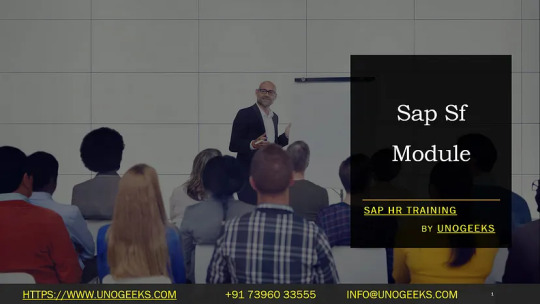
Title: SAP SuccessFactors: A Modular Guide to Transforming Your HR
Introduction:
Human Resources (HR) departments are pivotal in driving organizational success in today’s rapidly evolving business landscape. SAP SuccessFactors (SF) is a powerful ally, transforming traditional HR into a strategic force with its cloud-based suite of HR modules. In this blog, we’ll explore these modules and how they can revolutionize your HR processes.
What is SAP SuccessFactors?
SAP SuccessFactors is a cloud-based Human Capital Management (HCM) solution that streamlines and optimizes HR functions. It offers a comprehensive array of modules, each addressing specific HR needs. Whether you want to enhance employee engagement, optimize talent management, or gain actionable HR insights, SuccessFactors delivers the tools for success.
Key SAP SuccessFactors Modules
Let’s break down some of the most potent SAP SF modules:
Employee Central: The core of SuccessFactors. It serves as a centralized HR system of record, housing employee data, payroll, time and attendance, organizational structures, and more.
Recruiting: Streamlines your hiring processes with powerful tools for job postings, applicant tracking, candidate management, and seamless onboarding of new hires.
Onboarding: This provides a welcoming and structured experience for new employees. It automates tasks, provides essential information, and fosters early engagement.
Performance & Goals: Aligns employee goals with organizational objectives, fosters regular feedback, and drives continuous performance improvement.
Compensation: Helps you design and manage competitive compensation plans, ensuring fair and performance-based rewards.
Succession & Development: This department identifies future leaders, develops development plans, and creates a pipeline of talent for critical roles.
Learning: Offers a robust employee training and development platform, supporting diverse learning styles and tracking progress.
Benefits of Using SAP SuccessFactors
Improved Efficiency and Automation: Replaces manual, error-prone processes, saving valuable time and resources for HR teams.
Enhanced Employee Experience: Delivers personalized, self-service HR portals, fostering employee engagement and satisfaction.
Data-Driven Decision Making: Provides powerful analytics and reporting to uncover HR insights, drive informed decisions, and improve strategic workforce planning.
Global Scalability: Supports multinational organizations with a cloud-based system accommodating multi-country regulations and compliance.
Continuous Innovation: Benefits from regular updates and new feature releases, ensuring your HR technology stays at the cutting edge.
Getting Started with SAP SuccessFactors
Implementing SAP SuccessFactors takes careful planning. Here’s how to begin:
Assess Your Needs: Identify your HR pain points and areas for improvement.
Choose the Right Modules: Map those needs to specific SuccessFactors modules.
Partner with an Expert: Consider a certified SAP SuccessFactors consultant to ensure a smooth implementation.
Conclusion
SAP SuccessFactors is a game-changer, empowering HR to catalyze business growth. Its modular approach lets you tailor a solution to your organization’s unique needs. If you’re ready to modernize your HR, exploring SAP SuccessFactors is an investment you won’t regret.
youtube
You can find more information about SAP HR in this SAP HR Link
Conclusion:
Unogeeks is the No.1 IT Training Institute for SAP HR Training. Anyone Disagree? Please drop in a comment
You can check out our other latest blogs on SAP HR here – SAP HR Blogs
You can check out our Best In Class SAP HR Details here – SAP HR Training
———————————-
For Training inquiries:
Call/Whatsapp: +91 73960 33555
Mail us at: [email protected]
Our Website ➜ https://unogeeks.com
Follow us:
Instagram: https://www.instagram.com/unogeeks
Facebook: https://www.facebook.com/UnogeeksSoftwareTrainingInstitute
Twitter: https://twitter.com/unogeeks
2 notes
·
View notes
Text
SUCCESSFACTORS HCM

Transforming HR with SAP SuccessFactors HCM
In the fast-paced, ever-changing world of human resources, organizations need powerful tools to streamline processes, elevate the employee experience, and make data-driven decisions. Enter SAP SuccessFactors HCM (Human Capital Management), a leading cloud-based HR solution designed to do just that.
What is SuccessFactors HCM?
SAP SuccessFactors HCM is a comprehensive suite of HR modules that provides businesses with a centralized platform to manage the entire employee lifecycle regardless of size or industry. It covers the full range of HR functions, including:
Core HR & Payroll manages essential employee data, automates payroll, and precisely handles time and attendance.
Talent Management: Streamlines recruiting, onboarding, performance and goal management, learning, compensation, and succession planning.
Employee Experience Management: Enhances employee engagement through surveys, continuous feedback, and action planning.
HR Analytics and Workforce Planning: Delivers powerful insights, enables scenario modeling, and supports strategic people-related decisions.
Why Choose SuccessFactors HCM?
Here are some compelling advantages of using SuccessFactors HCM:
Cloud-Based Flexibility: SuccessFactors is a SaaS (Software-as-a-Service) solution. This means no hefty hardware investments, automatic updates, high accessibility, and the freedom to scale as needed.
Global Reach: Supports multinational operations with multiple languages and currencies and ensures compliance with local regulations.
Seamless Integration: Connects easily with other SAP solutions and third-party systems for a unified business environment.
Employee-Centric Design: Delivers personalized experiences and empowers employees with self-service tools.
Powerful Analytics: Helps HR leaders gain a real-time understanding of their workforce and make insights-based decisions.
Key Use Cases
SuccessFactors HCM can be transformative across various aspects of HR operations:
Streamlining Recruitment: Speed up finding and hiring top talent, ensuring a smooth candidate experience.
Boosting Employee Development: Personalize learning plans, track progress and promote growth within the organization.
Rewarding Performance: Accurately link performance assessments with compensation, ensuring fairness and motivation.
Insightful Planning: Make accurate workforce forecasts, conduct “what-if” scenario analysis, and optimize resource allocation.
Enhancing Engagement: Gather actionable feedback and insights into the overall employee experience.
Getting Started with SuccessFactors HCM
If you’re considering implementing SuccessFactors HCM, remember:
Thorough Assessment: Define your HR needs and how they align with organizational goals.
Specialized Partner: Work with an experienced SAP SuccessFactors implementation partner to ensure a smooth rollout
Change Management: Train your employees and the HR team on the new system. Focus on the benefits and support adoption.
Conclusion
SAP SuccessFactors HCM has the potential to redefine the way businesses manage their most valuable asset—their people. By embracing this platform, organizations can enhance efficiency, nurture talent, gain deeper insights, and build a more engaged workforce.
youtube
You can find more information about SAP HR in this SAP HR Link
Conclusion:
Unogeeks is the No.1 IT Training Institute for SAP HR Training. Anyone Disagree? Please drop in a comment
You can check out our other latest blogs on SAP HR here – SAP HR Blogs
You can check out our Best In Class SAP HR Details here – SAP HR Training
———————————-
For Training inquiries:
Call/Whatsapp: +91 73960 33555
Mail us at: [email protected]
Our Website ➜ https://unogeeks.com
Follow us:
Instagram: https://www.instagram.com/unogeeks
Facebook: https://www.facebook.com/UnogeeksSoftwareTrainingInstitute
Twitter: https://twitter.com/unogeeks
2 notes
·
View notes
Text
SAP HCM
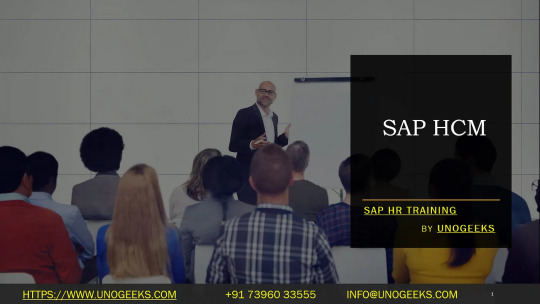
Title: The Power of SAP HCM: Transforming Your HR Operations
Introduction
A robust Human Capital Management (HCM) system is crucial in today’s rapidly evolving business landscape. This is where SAP HCM enters the picture. SAP HCM is a comprehensive suite designed to streamline and optimize all core HR processes, delivering efficiency across your entire organization. Let’s explore what makes SAP HCM so powerful.
What is SAP HCM?
SAP HCM, previously known as SAP HR, sits at the heart of SAP’s newer Human Experience Management (HXM) suite, SAP SuccessFactors. It’s a cloud-based solution offering a range of modules to manage the entire employee lifecycle, including:
Recruitment and Onboarding: Attract, source, hire, and seamlessly onboard the best talent.
Talent Management: Develop employees with performance management, goal setting, succession planning, and training.
Core HR (Personnel Administration): Manage essential employee data, payroll, time, and attendance.
Workforce Analytics and Reporting: Get real-time data insights to support strategic decision-making.
Why Choose SAP HCM?
Improved Employee Experience (EX): SAP HCM puts the employee at the center with intuitive self-service portals, fostering engagement and driving satisfaction.
Boost HR Efficiency: Automate manual HR tasks, saving time and resources while reducing errors.
Streamlined Global Operations: Manage HR processes consistently and competently across countries and regions.
Data-Driven Empowerment: Robust analytics tools enable strategic workforce planning and evidence-based decision-making.
Scalability and Adaptability: SAP HCM is flexible and grows with your business, adjusting to changing HR needs.
Key SAP HCM Modules
While it’s impossible to cover every module or feature, here’s a glimpse into some of the most critical SAP HCM solutions:
Organizational Management: Build your organization’s hierarchical structure, reporting lines, and job descriptions.
Personnel Administration: Centrally manage employee records, contact information, and crucial HR data.
Time Management: Track work schedules absences, calculate leave entitlements, and streamline time-administration processes.
Payroll: Accurately process payroll, meet local tax regulations, and handle benefits complexities.
The Future with SAP SuccessFactors
SAP HCM is continually evolving, and with the introduction of the broader SAP SuccessFactors suite, HR departments now have access to even more advanced tools and features. This includes solutions for continuous performance management, social collaboration, engaging learning experiences, and an emphasis on the holistic employee journey, transforming HCM into HXM (Human Experience Management).
Getting Started with SAP HCM
If you’re looking to unlock efficiency, improve employee satisfaction, and gain valuable HR insights, exploring SAP HCM is a worthwhile venture. Careful planning and teaming up with an experienced SAP implementation partner will ensure your SAP HCM journey is successful. https://youtu.be/61LqSu0GI-Y
You can find more information about SAP HR in this SAP HR Link
Conclusion:
Unogeeks is the №1 IT Training Institute for SAP HR Training. Anyone Disagree? Please drop in a comment
You can check out our other latest blogs on SAP HR here — SAP HR Blogs
You can check out our Best In Class SAP HR Details here — SAP HR Training
Follow & Connect with us:
— — — — — — — — — — — -
For Training inquiries:
Call/Whatsapp: +91 73960 33555
Mail us at: [email protected]
Our Website ➜ https://unogeeks.com
Follow us:
Instagram: https://www.instagram.com/unogeeks
Facebook: https://www.facebook.com/UnogeeksSoftwareTrainingInstitute
Twitter: https://twitter.com/unogeeks
2 notes
·
View notes
Text
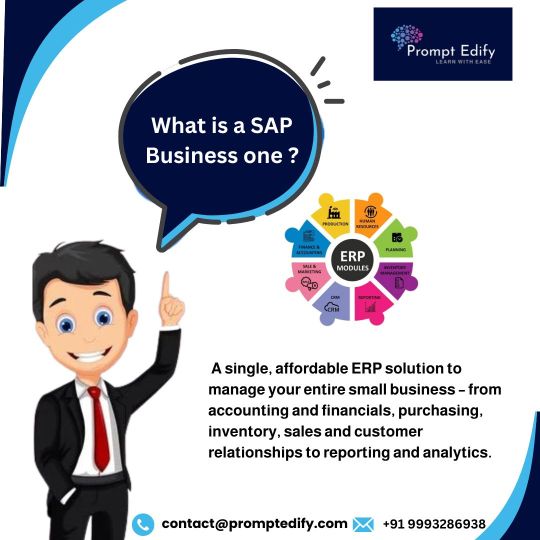
Overview:
SAP Business One (SAP B1) implemented at Prompt Edify, Rwanda, serves as an integrated enterprise resource planning (ERP) solution tailored for small and medium-sized enterprises (SMEs).
Streamlined Operations:
Facilitates seamless management of core business functions including accounting, sales, purchasing, inventory, and production, enhancing operational efficiency.
Localized Adaptation:
Customized to meet specific business requirements and comply with Rwandan regulatory standards, ensuring legal and financial compliance.
Enhanced Financial Management:
Enables accurate financial reporting, budgeting, and forecasting, empowering Prompt Edify with insightful decision-making capabilities.
Inventory Optimization:
Provides real-time visibility into inventory levels, facilitating better inventory control, reducing stockouts, and optimizing procurement processes.
Streamlined Sales Process:
Automates sales processes from lead generation to order fulfillment, improving customer satisfaction and sales performance.
Improved Customer Relationship Management (CRM):
Centralizes customer data, enabling Prompt Edify to deliver personalized experiences, strengthen customer relationships, and drive loyalty.
Data-driven Insights:
Generates comprehensive reports and analytics, empowering Prompt Edify with actionable insights to identify trends, opportunities, and challenges.
Scalability and Growth:
Supports business expansion by offering scalability, flexibility, and easy integration with other systems as Prompt Edify grows and diversifies its operations.
User-friendly Interface:
Intuitive interface and user-friendly features enhance employee productivity, reducing training time and ensuring rapid adoption across the organization.
Tech Support and Maintenance:
Access to ongoing technical support and maintenance services ensures smooth operation and timely resolution of any issues, minimizing downtime.
Long-term Value:
Investment in SAP Business One offers Prompt Edify long-term value through increased operational efficiency, cost savings, and sustained growth in the dynamic Rwandan market.
Implementing SAP Business One at Prompt Edify underscores a strategic commitment to leveraging advanced technology to drive innovation, efficiency, and competitiveness in Rwanda's business landscape.
📱 (+91) 99932 86938 ��� [email protected] 🌐 www.promptedify.com 🔗 You can chat with us on WhatsApp 📑 Book you spot now👉 Register Now
#sap certification#sapconsultant#sap consulting services#sap online training#sap fico course#sap modules#sap_certification#career in sap#sap business one
2 notes
·
View notes
Text
The Collaboration of Clinical Data Management and Biostatistics in Evidence-Based Medicine
Introduction:
In the realm of clinical research, the seamless collaboration between clinical data management (CDM) and biostatistics is paramount for ensuring the accuracy, reliability, and integrity of study outcomes. This dynamic partnership plays a pivotal role in transforming raw data into meaningful insights that drive evidence-based medical decisions. In this blog post, we delve into the essential interactions between CDM and biostatistics, highlighting their respective contributions and synergies in the clinical research landscape.

Data Collection and Database Design:
CDM professionals are responsible for designing robust data collection tools and establishing comprehensive data management plans.
Biostatisticians collaborate closely to ensure that data collection instruments capture relevant variables with precision, enabling accurate statistical analysis.
Joint efforts streamline the development of databases that adhere to regulatory standards and facilitate efficient data entry, validation, and cleaning processes.
Data Quality Assurance:
CDM specialists implement quality control measures to identify and address data discrepancies, inconsistencies, and errors.
Biostatisticians contribute expertise in data validation and verification, conducting thorough checks to maintain data integrity.
Continuous communication between CDM and biostatistics teams fosters proactive identification and resolution of data quality issues, enhancing the reliability of study findings.
Statistical Analysis Planning:
Biostatisticians from Biostatistics Services collaborate with CDM professionals to formulate robust statistical analysis plans (SAPs) tailored to study objectives and design.
CDM experts provide insights into data structure, collection processes, and potential biases, informing statistical modeling approaches and hypotheses testing strategies.
The synergy between CDM and biostatistics ensures that analytical methodologies align with data characteristics, maximizing the validity and interpretability of study results.
Data Interpretation and Reporting:
Biostatisticians play a pivotal role in analyzing study data, interpreting statistical findings, and deriving meaningful conclusions.
CDM specialists assist in contextualizing statistical results within the broader clinical framework, elucidating the implications for patient care and treatment strategies.
Collaborative review and refinement of study reports and publications ensure accurate representation of data insights and statistical significance.
Regulatory Compliance and Audits:
CDM professionals and biostatisticians collaborate to ensure compliance with regulatory requirements and industry standards governing data management and statistical analysis.
Joint efforts facilitate preparation for regulatory inspections and audits, with comprehensive documentation and audit trails supporting data integrity and traceability.
Continuous monitoring and adherence to regulatory updates and guidelines mitigate risks and enhance the credibility of clinical research outcomes.
Conclusion:
The intricate interplay between clinical data management services and biostatistics underscores the importance of collaborative synergy in advancing evidence-based medicine. By leveraging their respective expertise and working in tandem throughout the research lifecycle, CDM and biostatistics teams synergize efforts to uphold data quality, integrity, and regulatory compliance. Clinical data management services, such as those provided by Global Pharma Tek, play a crucial role in designing robust data collection tools, establishing comprehensive data management plans, and implementing quality control measures to ensure the accuracy and reliability of study data. This harmonious partnership not only drives scientific discovery and innovation but also contributes to improved patient outcomes and healthcare decision-making.
2 notes
·
View notes
Text
Charting the Course to SAP HANA Cloud
The push towards SAP HANA cloud shift stems from the need for agility and responsiveness in a dynamic business climate. The cloud promises reduced infrastructure expenses, robust data analytics, and the nimbleness to address changing needs quickly. However, for many companies, transitioning from on-premise SAP HANA to the cloud involves navigating concerns around data security, performance, and potentially relinquishing control of business-critical ERP systems.
SAP HANA Enterprise Cloud: A Tailored Offering
In light of these challenges, SAP presented the SAP HANA Enterprise Cloud (HEC), a private cloud service designed expressly for mission-critical workloads. HEC advertises no compromise on performance, integration, security, failover, or disaster recovery. It spotlights versatility, strong customer support, and end-to-end coverage - from strategic planning to application management. This offering intends to provide the cloud’s agility and innovation under SAP’s direct guidance and expertise.
Actual Delivery of HANA Enterprise Cloud
Despite SAP’s messaging, the HEC’s delivery involves a consortium of third-party providers, including HPE, IBM, CenturyLink, Dimension Data, and Virtustream. SAP collaborates with these partners, who bid on projects often awarded to the lowest bidder, to leverage specialized capabilities while upholding SAP’s standards.
Weighing the Pros and Cons
Partnering with competent vendors ensures clients receive secure, best-practice SAP hosting and support. HEC’s comprehensive solution integrates licensing, infrastructure, and support with touted scalability and integration.
However, several customer challenges emerge. Firstly, leveraging SAP’s brand for cloud hosting and SAP managed services risks diminishing anticipated cost savings. Secondly, the lack of direct engagement with third-party providers raises concerns about entrusting critical ERP operations to unseen partners. This dynamic obscures visibility and control over SAP HANA migration and management.
Furthermore, the absence of a direct relationship between SAP HANA users and cloud suppliers may complicate support, especially for urgent issues warranting rapid response. While SAP’s ecosystem aims to guarantee quality and security, intermediation can hinder the timely resolution of critical situations, affecting system uptime and operations.
SAP HANA Cloud: A Strategic Decision
As SAP systems become increasingly vital, migrating SAP HANA is not simply a technical or operational choice but a strategic one. SAP HANA transcends a database or software suite – it constitutes a competitive advantage that, when optimized, can spur tremendous innovation and success. This migration necessitates meticulous planning, execution, and governance to ensure the transition empowers rather than compromises SAP HANA’s strategic value.
In this context, selecting the ideal cloud model and service providers represents critical decisions. Companies must scrutinize partners beyond cost, evaluating track records, SAP skills, security protocols, and the aptitude to deliver personalized, responsive service.
The Future SAP HANA Cloud Trajectory
As we advance into 2024, the SAP DATA Cloud Analytics landscape continues evolving. Innovations in cloud technology, security, and service creation provide new prospects for migration planning. Firms must stay updated on cloud service advancements, SAP’s strategic direction, and cloud shift best practices to navigate this transition successfully.
To accomplish this, companies should:
Collaborate cross-functionally to align SAP HANA cloud plans with broader business goals and technology roadmaps.
Ensure chosen cloud environments and suppliers meet rigorous data security, privacy, and regulatory standards.
Assess infrastructure ability to support SAP HANA performance requirements and scale amid fluctuating demands.
Institute clear governance and support structures for effective issue resolution throughout and post-migration.
Transitioning SAP HANA to the cloud is complex but ultimately rewarding, unlocking efficiency, agility, and innovation when executed deliberately. By weighing the strategic, operational, and technical dynamics, businesses can drive this migration smoothly, fully capturing SAP HANA’s power to fuel future prosperity.
2 notes
·
View notes
Text
PMO-Beratung

Website: https://www.pureconsultant.de/de/beratung/project-management-office-beratung/
Address: Hohenstaufenring 57a, 50674 Köln, Germany
Pure Consultant bietet professionelle PMO-Beratungsdienstleistungen an. Unser erfahrenes Team von PMO-Beratern steht Ihnen zur Seite, um maßgeschneiderte Lösungen zu entwickeln und eine effektive PMO-Transformation in Ihrem Unternehmen zu ermöglichen. Wir bringen umfassende Expertise im Bereich PMO Consulting ein, um individuelle Strategien zu entwerfen und die Effizienz Ihres Projektmanagements zu steigern. Unsere Fokussierung liegt darauf, Ihre Organisation durch effektive Schulungen und praxisnahe Anleitung auf dem Weg zu einem effizienten PMO zu begleiten.
Provenexpert: https://www.provenexpert.com/pcg-pure-consultant-gmbh/
Xing: https://www.xing.com/pages/pcgpureconsultantgmbh
Trustpilot: https://de.trustpilot.com/review/pureconsultant.de
Linkedin: https://www.linkedin.com/organization-guest/company/pcgpureconsultantgmbh
Keywords:
pmo beratung
pmo consultant
pmo consulting services
pmo consulting firms
pmo consulting companies
project management office consultant
platinum pmo consulting
atkins pmo consultant
consulting
business consultant
power bi consultant
it consulting
salesforce consultant
hr consulting
marketing consultant
hr consulting firms
seo consultant
consulting firms
sharepoint consultant
management consulting
netsuite consultant
strategy consulting
business consulting services
healthcare consulting
salesforce implementation partner
business consultant near me
accenture consulting
route consultant
small business consultant
cyber security consultant
sustainability consultant
franchise consultant
consulting services
digital transformation consultant
ai consultant
wealth management consultant
consulting company
google analytics consultant
mba consulting
digital marketing consultant
restaurant consultant
healthcare consulting firms
hr consulting services
human resources consultant
devops consulting
small business consulting services
environmental consultant
business plan consultant
technology consultant
salesforce consulting companies
sap consulting
bain and company
supply chain consultant
brand consultant
tech consulting
financial consulting
software consultant
ey consulting
hr consulting companies
dei consultant
starting a consulting business
data science consulting
product management consulting
business development consultant
project management consultant
safety consultant
software consulting companies
change management consultant
management consulting firms
esg consulting firms
2 notes
·
View notes
Text

Unlock SAP Ariba's potential with online training! Proexcellency offers flexible, cost-effective courses led by expert instructors. Gain hands-on experience, explore case studies, and prepare for certifications. Master supplier management, sourcing, purchasing, invoicing, and analytics. Advanced modules cover customization, integration, analytics, and compliance. Invest for reduced costs, increased efficiency, data control, and supplier relationships. Stay competitive with digital procurement. Start your SAP Ariba journey with Proexcellency now! 🌐 [Explore courses](insert link) | 📞 +91 8722079509 | 📧 [email protected] |
2 notes
·
View notes
Text
Unveiling the Strategic Impact: Understanding the Uses of Learning SAP MM Course at SAP Training Institute
In the realm of enterprise resource planning (ERP), SAP MM (Materials Management) stands as a critical module that plays a pivotal role in managing an organization's materials, procurement processes, and inventory. The SAP Training Institute offers a comprehensive SAP MM course designed to equip professionals with the skills necessary to harness the full potential of this module. In this exploration, we will uncover the multifaceted uses and strategic implications of learning SAP MM at the SAP Training Institute.
USES OF LEARNING SAP MM COURSE AT STUDY GIANT ACADEMY
Efficient Materials Management
At the core of SAP MM lies the ability to streamline materials management processes. Professionals undergoing SAP MM training gain insights into the efficient handling of procurement, inventory management, and logistics, ensuring that an organization's resources are optimally utilized.
Optimized Procurement Processes
Learning SAP MM empowers individuals to navigate the complexities of procurement. From the creation of purchase requisitions to vendor evaluation, the course covers the end-to-end procurement cycle. This knowledge is invaluable in enhancing the efficiency of procurement processes and reducing costs through effective supplier management.
Inventory Control and Visibility
The SAP MM course at the institute delves into the intricacies of inventory management. Participants learn how to maintain optimal stock levels, track goods movements, and implement inventory control measures. This not only prevents stockouts but also minimizes excess inventory, contributing to cost savings.
Integration with Other SAP Modules
SAP MM does not operate in isolation; it integrates seamlessly with other SAP modules such as SAP SD (Sales and Distribution) and SAP PP (Production Planning). Understanding these integration points is a key focus of the training, providing participants with a holistic understanding of how materials management intersects with other business processes.
Vendor Relationship Management
Effective vendor management is crucial for organizational success. SAP MM training equips professionals with the skills to manage vendor relationships efficiently. From vendor selection to performance evaluation, participants gain insights into fostering collaborative and mutually beneficial partnerships.
Compliance and Documentation
In the ever-evolving landscape of regulations and compliance, the SAP MM course emphasizes the importance of adhering to industry standards. Participants learn how to generate accurate and compliant documentation, ensuring that the organization meets regulatory requirements and operates ethically.
Cost Savings through Strategic Sourcing
Strategic sourcing is a key aspect of SAP MM, and the training program focuses on enabling professionals to make informed decisions in the procurement process. This includes identifying cost-effective sourcing strategies, negotiating favorable terms, and ultimately contributing to substantial cost savings for the organization.
Real-Time Reporting and Analytics
SAP MM training goes beyond transactional processes and delves into the realm of reporting and analytics. Participants learn how to generate real-time reports on materials usage, procurement trends, and inventory turnover. This data-driven approach empowers organizations to make informed decisions for future planning.
Career Advancement Opportunities
Completion of the SAP MM course from the SAP Training Institute is not just a skill acquisition; it opens doors to new career opportunities. Professionals equipped with SAP MM expertise are sought after by organizations across industries, positioning graduates for roles such as SAP MM consultant, materials manager, or procurement specialist.
Continuous Learning and Updates
The SAP MM course is designed to foster continuous learning. With regular updates on the latest features and functionalities of SAP MM, participants stay abreast of industry advancements. This commitment to ongoing education ensures that professionals remain valuable assets to their organizations.
WHY DO YOU JOIN STUDY GIANT ACADEMY ?
Learning SAP MM Course at Study Giant SAP Training Institute is an investment in acquiring skills that extend beyond the confines of materials management. The strategic uses of SAP MM span procurement, inventory control, vendor management, and compliance, positioning professionals as strategic assets in their organizations. As businesses increasingly rely on SAP solutions for efficient materials handling, professionals equipped with SAP MM expertise are well-prepared to contribute to organizational success and navigate the intricacies of modern supply chain management.
Study Giant Academy is not just a training institution; it's a hub for transformative experiences. Whether you're starting your SAP journey or looking to upskill, we invite you to be a part of our thriving community. Unleash the power of SAP, embrace digital transformation, and redefine what's possible in your career.
Embark on this journey with us, and let Study giant Academy be your guide to unlocking the potential within you. Here's to many more years of empowering careers and shaping the future of digital excellence!
2 notes
·
View notes
Text
What is the best IFRS software
Best International Financial Reporting Standards (IFRS) software because the choice of software depends on the specific needs and requirements of the organization. Different companies may have distinct preferences based on factors such as size, industry, complexity of financial reporting, and integration capabilities with existing systems.
However, there are several reputable software solutions that are commonly used for IFRS reporting and compliance. Keep in mind that the landscape might have changed, and new solutions may have emerged since my last update.
Workiva:
Workiva offers cloud-based solutions for finance, compliance, and data management. It is known for its collaborative and workflow management features.
Tagetik (owned by Wolters Kluwer):
Tagetik provides a unified platform for financial performance management, including IFRS reporting. It is designed to streamline funds processes and improve compliance.
Oracle Financial Services Analytical Applications (OFSAA):
Oracle's OFSAA suite includes modules for various budgetary functions, including regulatory info. It is designed to help wealthy institutions comply with IFRS and other reporting standards.
SAP S/4HANA:
SAP's ERP solution, S/4HANA, includes financial modules that can support IFRS. SAP is widely used in large enterprises across various industries.
Datar ails:
Data Rails offers a platform that automates funds reporting, budgeting, and forecasting. It is designed to improve the accuracy and efficiency of income processes.
Hubble (by insight software):
Hubble is an integrated suite of performance management apps. It provides solutions for financial reporting, analytics, and planning.
OneStream Software:
OneStream offers a unified CPM (Corporate Performance Management) platform that includes solutions for financial consolidation and planning, supporting IFRS compliance.
When choosing an IFRS software solution, it's essential to consider factors such as the organization's specific information needs, budget, scalability, ease of use, and integration capabilities with existing systems. Additionally, staying informed about updates and reviews in the financial software market is crucial to ensuring that the chosen solution meets the latest standards and regulations.
2 notes
·
View notes
Text
SAP's Role in Building Smart Cities for a Brighter Tomorrow
The globe is quickly urbanizing, and cities face the task of effectively managing resources and services while enhancing citizens' quality of life. Smart cities are developing as the solution to these urban difficulties, fueled by technology and data-driven solutions. In this blog, we'll look at how SAP, a global leader in enterprise software, is transforming cities into smart, sustainable, and networked centres of innovation and advancement.
Deciphering Smart Cities
Before we get into SAP's smart solutions for smart cities contributions, we need define what we mean by "smart cities." These cities use digital technology, data analytics, IoT (Internet of Things), AI (Artificial Intelligence), and cloud computing to improve transportation, energy use, waste management, public safety, and other areas of city life. The main objective is to build urban settings that are responsive, adaptive, and environmentally friendly.
SAP's Impact on Smart Cities
SAP's extensive experience in enterprise software and data management positions it as a key player in the smart city revolution. Here's a closer look at how SAP smart solutions for smart cities is shaping the future of cities:
Data Integration: Smart cities generate vast amounts of data from diverse sources, including sensors, mobile apps, and government systems. SAP's data integration and analytics tools empower cities to efficiently collect, process, and analyze this data in real time. Such smart solutions for smart cities insights prove invaluable for informed decision-making on resource allocation, infrastructure maintenance, and service optimization.
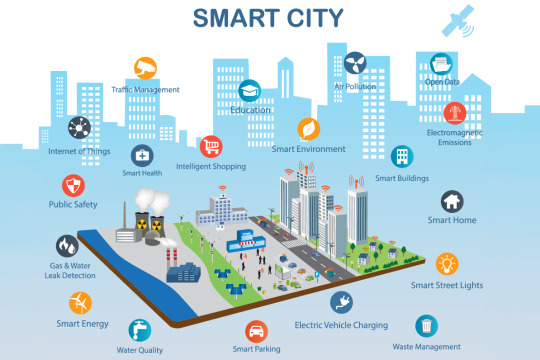
IoT Empowerment: IoT forms the bedrock of smart cities, and SAP's IoT solutions facilitate the seamless connection and management of countless devices and sensors. From smart traffic lights to waste bins, this connectivity allows real-time monitoring and control, enhancing everything from traffic management to environmental sustainability.
Predictive Analytics: SAP's predictive analytics tools enable cities to foresee trends and challenges. For instance, predictive maintenance identifies when critical infrastructure, like bridges or water pipes, may need attention before a major issue arises, saving both time and resources.
Citizen Engagement: Smart cities thrive on citizen involvement in decision-making. SAP provides platforms for citizen engagement, such as mobile apps and online portals, where residents can report issues, take part in surveys, and access information on city services and projects.
Energy Efficiency: Energy management is a top priority for smart cities, and SAP's smart solutions for smart cities help cities monitor and optimize energy consumption in public buildings, street lighting, and other municipal facilities. This smart solutions for smart cities reduces costs and environmental impact.
Conclusion
SAP's essential role in smart city development is assisting cities throughout the world in addressing the complex issues of rising urbanization and resource management. Cities are becoming more efficient, sustainable, and responsive to their inhabitants' demands by leveraging SAP's expertise in data management, IoT, and analytics. The influence of SAP smart business on the future of smart cities is poised to grow as technology progresses, providing more livable, connected, and resilient urban settings for future generations.
3 notes
·
View notes
Text
The Crucial ERP System Examples: Transforming Business Operations

In today’s fiercely competitive business realm, the quest for operational efficiency and streamlined management is paramount. Enterprise Resource Planning (ERP) systems stand tall as technological marvels, revolutionizing the way businesses operate. These robust software solutions amalgamate various functions within a unified framework, enabling seamless coordination across departments and facilitating data-driven decision-making.
This exploration ventures into the realm of ERP systems, shedding light on a spectrum of exemplary solutions that have reshaped modern business operations. From stalwarts like SAP ERP and Oracle ERP Cloud to innovative players like Microsoft Dynamics 365 and Odoo, each system represents a unique amalgamation of features, functionalities, and industry applications.
This comprehensive journey traverses the functionalities, industry adaptability, and transformative potentials of these ERP systems. Understanding their intricacies is pivotal for businesses seeking to optimize processes, unlock efficiencies, and navigate the complexities of today’s business landscape. Join this insightful exploration to unravel the significance and impact of these ERP system examples in shaping the future of business operations.
ERP System Examples
1. SAP ERP: Revolutionizing Business Management
SAP ERP has solidified its position as a leader by providing an all-encompassing suite covering critical business functions. Beyond its core modules in finance, HR, and supply chain, SAP offers specialized applications for industry-specific needs. For instance, SAP S/4HANA, an intelligent ERP, integrates AI and analytics for real-time insights, empowering businesses to adapt swiftly to market changes.
The scalability of SAP ERP is noteworthy, catering to startups aiming for growth and global corporations managing complex operations. It provides modular solutions, enabling businesses to adopt specific functionalities based on their immediate needs.
2. Oracle ERP Cloud: Innovating Operations in the Cloud
Oracle ERP Cloud’s robust suite extends far beyond traditional ERP capabilities. It embraces emerging technologies like AI, machine learning, and blockchain to drive innovation. Its predictive analytics empower businesses to anticipate market trends, optimize supply chains, and mitigate risks effectively.
The cloud-based structure of Oracle ERP Cloud ensures not just accessibility but also scalability without compromising security. It enables seamless integration with other Oracle Cloud applications, fostering a unified ecosystem for comprehensive business management.
3. Microsoft Dynamics 365: Integrating CRM and ERP Capabilities
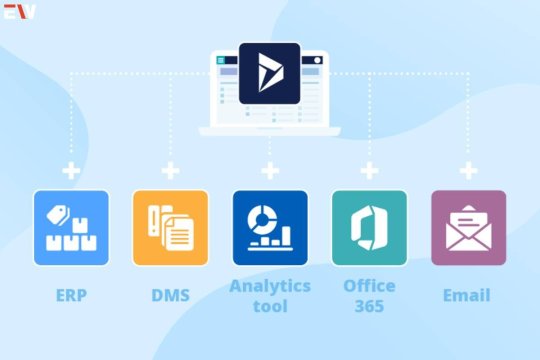
Microsoft Dynamics 365 is a fusion of CRM and ERP functionalities, providing a holistic platform for businesses. Unlike its core ERP modules, Dynamics 365 offers advanced tools for customer engagement, field service, and marketing automation. Its flexibility lies in its modularity, allowing businesses to tailor their systems by choosing specific applications that align with their objectives.
Moreover, its integration with Microsoft Office 365 and Power Platform strengthens collaboration and data analysis, facilitating informed decision-making across departments.
4. NetSuite: Empowering Diverse Industries
NetSuite’s cloud-based ERP system addresses the complex needs of various industries. Its suite encompasses solutions for financial management, e-commerce, and inventory control. Beyond the core ERP functionalities, NetSuite offers industry-specific modules, such as SuiteCommerce for retail businesses and SuiteSuccess for services, enhancing its appeal across diverse sectors.
The scalability and adaptability of NetSuite make it a preferred choice for businesses experiencing rapid growth or seeking to expand into new markets.
5. Infor ERP: Tailored Solutions for Specific Sectors
Infor’s industry-specific ERP solutions cater to the nuanced requirements of sectors like healthcare, manufacturing, and distribution. In addition to its standard ERP functionalities, Infor focuses on specialized applications such as Infor CloudSuite Healthcare for healthcare organizations and Infor LN for manufacturing, ensuring tailored solutions for sector-specific challenges.
Infor’s commitment to innovation and addressing sector-specific complexities underscores its relevance in the ERP landscape.
6. Epicor ERP: Amplifying Industry Operations
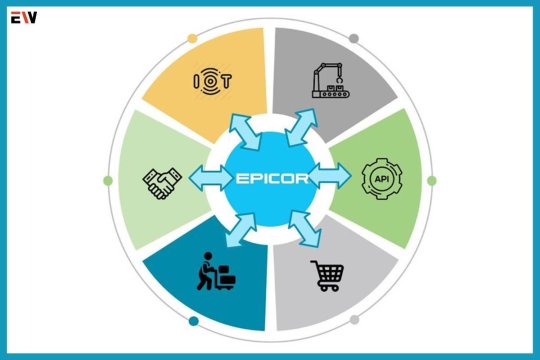
Epicor ERP excels in catering to industries such as manufacturing, distribution, retail, and services. Its core ERP functionalities are complemented by advanced analytics and business intelligence tools. Epicor’s Smart Inventory Planning and Optimization (IPO) tool, for instance, utilizes AI to enhance inventory management, improving efficiency and reducing costs.
Moreover, its agile architecture enables easy customization and integration with third-party applications, providing businesses with a highly adaptable solution.
7. Odoo: Flexibility and Customization
Odoo’s open-source ERP system offers an extensive suite of applications covering CRM, inventory management, project management, and more. What sets Odoo apart is its modular nature, allowing businesses to select and integrate specific applications as per their requirements. Odoo’s flexibility and affordability are especially beneficial for small to medium-sized enterprises seeking customizable solutions without exorbitant costs.
The Value of ERP Systems in Modern Business
ERP systems serve as catalysts for efficiency, productivity, and growth:
Streamlined Operations: Automating tasks streamlines processes, reducing manual errors and optimizing resource allocation.
Enhanced Data Management: Centralized databases ensure data consistency and accuracy, fostering informed decision-making.
Agile Decision-Making: Real-time data access empowers businesses to make agile decisions, staying ahead in dynamic markets.
Customer-Centric Approach: Integrated CRM functionalities enable businesses to deliver personalized services, boosting customer satisfaction and loyalty.
Making Informed Choices: Selecting the Right ERP System

The process of choosing an ERP system involves careful evaluation and alignment with a business’s unique needs. Understanding the scalability, integration capabilities, and industry-specific functionalities of each system is crucial for successful adoption.
Conclusion: Embracing ERP Systems for Sustainable Growth
The landscape of ERP systems continues to evolve, offering businesses versatile solutions to streamline operations, enhance efficiency, and foster sustainable growth. From SAP’s scalability to Oracle’s cloud-driven innovation and Odoo’s customization prowess, each system exemplifies the diverse capabilities shaping modern business management.
Selecting the right ERP system aligned with specific needs remains pivotal for organizations seeking resilience and competitiveness. As businesses strive for optimization and adaptability, embracing these transformative technologies ensures a strategic advantage in an ever-evolving market. It stands as a pillar of efficiency, empowering businesses to navigate complexities and drive success through informed decisions and streamlined operations.
Also Read: A Deep Dive into Corporate Wellness Programs for a Healthier, Happier Workplace
#ERPRevolution#BusinessTransformation#TechInnovation#DigitalTransformation#EnterpriseSolutions#InnovationInBusiness#TechLeadership
2 notes
·
View notes
Text
How to Achieve Lean Manufacturing: A Step-by-Step Guide to SAP ERP Production Planning
Lean manufacturing has become a key focus for organizations striving to optimize their production processes and eliminate waste.
By implementing efficient production planning strategies, businesses can enhance productivity, reduce costs, and deliver high-quality products to customers.
One effective approach to achieving lean manufacturing is utilizing SAP ERP production planning.
In this article, we will provide a step-by-step guide to help you harness the power of SAP ERP in your pursuit of lean manufacturing excellence.
Step 1: Understand Your Production Requirements
Before diving into SAP ERP production planning, it is crucial to have a clear understanding of your production requirements.
Evaluate your production capacity, demand forecasts, and lead times to determine the optimal production plan.
By comprehending your needs and constraints, you can align your SAP ERP production planning efforts accordingly.
Step 2: Configure SAP ERP Production Planning
Once you grasp your production requirements, it's time to configure SAP ERP production planning to suit your organization's specific needs.
Customize the system according to your production processes, resource availability, and scheduling preferences.
SAP ERP provides a range of modules and tools that can be tailored to align with your unique production environment.
Step 3: Define Bills of Material and Routings
To effectively plan and execute production processes, defining accurate bills of material (BOM) and routings within SAP ERP is essential.
BOMs outline the components required to manufacture a product, while routings specify the sequence of operations involved.
By inputting precise BOMs and routings, you can ensure that your production planning is based on reliable data, leading to improved efficiency and reduced waste.
Step 4: Create Production Orders
Once your BOMs and routings are in place, it's time to create production orders within SAP ERP. Production orders serve as the foundation for executing your production plan.
They contain vital information such as the quantity to be produced, the resources required, and the estimated completion date.
By generating production orders, you can effectively track and manage the progress of your manufacturing processes.
Step 5: Optimize Production Scheduling
Efficient production scheduling is crucial for achieving lean manufacturing.
Utilize SAP ERP's scheduling capabilities to optimize the allocation of resources, minimize idle time, and reduce production bottlenecks.
By leveraging features such as capacity leveling and finite scheduling, you can ensure that your production lines operate at their maximum potential, enabling smoother workflows and faster turnaround times.
Step 6: Monitor and Analyze Production Performance
To sustain continuous improvement in your production processes, monitoring and analyzing production performance using SAP ERP is vital.
Leverage the system's reporting and analytics features to gain insights into key performance indicators (KPIs) such as cycle time, yield, and scrap rates.
By identifying areas for improvement and making data-driven decisions, you can further streamline your production operations and enhance overall efficiency.
Conclusion
Achieving lean manufacturing requires a systematic approach that eliminates waste, optimizes resources, and enhances productivity.
By following this step-by-step guide to SAP ERP production planning, organizations can harness the power of technology to drive lean manufacturing excellence.
From understanding production requirements to monitoring performance, SAP ERP offers a comprehensive suite of tools to support your journey toward lean manufacturing.
Embrace the power of SAP ERP and unlock the potential for improved efficiency, reduced costs, and increased customer satisfaction in your production processes.Michael Management SAP ERP training offers an effective way to learn all things SAP ERP. Michael Management’s raining is created using SAP's Best Practices, ensuring alignment with industry standards and optimized processes. Choose Michael Management to experience hands-on SAP training and gain practical experience in using SAP software effectively. Unleash your true potential with Michael Management and experience SAP training that accelerates your learning and supports your success.
For more details, visit: https://www.michaelmanagement.com/browse/sap-erp
3 notes
·
View notes
Text
Career Paths for SAP S/4 HANA FI Certified Professionals
In today's rapidly evolving business landscape, organizations need to leverage data and technology to stay competitive. One of the key players in this arena is SAP, a global leader in enterprise software solutions. SAP's S/4 HANA Financial Accounting (FI) module has become integral to the operations of countless organizations, making certified professionals in this field highly sought after.
If you're considering a career in SAP S/4 HANA FI, you'll be pleased to know that there are numerous career paths open to you. In this article, we'll explore nine exciting career options for SAP S/4 HANA FI certified professionals.Before we get into these job choices, Finprov Learning is a reliable platform that offers high-quality SAP training and certification programs. Finprov Learning can help you succeed in this industry and obtain your needed skills.
Careers in SAP S/4 HANA FI
SAP S/4 HANA FI Consultant
To implement, adapt, and improve your client's financial accounting systems, you will collaborate closely with them as a SAP S/4 HANA FI consultant. This position includes reviewing business procedures, setting up SAP systems, and offering continuous assistance and training.
Financial Analyst
S/4 HANA SAP Professionals with FI certification are well-suited for employment as financial analysts. They can use their knowledge of SAP systems to analyze financial data, provide reports, and offer insights to help organizations make better decisions.
SAP S/4 HANA FI Project Manager
In SAP implementations, project management is essential. Strong communicators and project managers who are SAP S/4 HANA FI certified may successfully oversee the planning and implementation of SAP projects.
SAP S/4 HANA FI System Administrator
SAP systems need to be maintained and troubleshot by system administrators. You can operate as a system administrator, ensuring the efficient operation of financial modules and resolving any technical issues if you have certification in SAP S/4 HANA FI.
SAP S/4 HANA FI Trainer
If you enjoy teaching and are passionate about SAP, consider becoming an SAP S/4 HANA FI trainer. Many organizations require in-house employee training, and your expertise can be invaluable in this role.
SAP S/4 HANA FI Data Analyst
Data analytics is a growing field, and SAP S/4 HANA FI-certified professionals can apply their skills to extract valuable insights from financial data. This career path involves using tools like SAP Analytics Cloud to analyze and visualize financial information.
SAP S/4 HANA FI Auditor
Financial audits are a crucial part of any business. SAP S/4 HANA FI certified professionals can work as auditors, ensuring financial compliance, risk management, and fraud detection within organizations.
SAP S/4 HANA FI Solution Architect
Solution architects design and plan the implementation of SAP solutions, ensuring they align with business objectives. With certification in SAP S/4 HANA FI, you can become a solution architect, shaping the financial systems of the future.
SAP S/4 HANA FI Business Analyst
Business analysts bridge the gap between technical SAP knowledge and business processes. They evaluate how SAP solutions can meet specific business needs and work on improving financial processes.
Conclusion
The certified SAP S/4 HANA FI professional opens doors to numerous exciting and financially rewarding opportunities. Whether you're inclined to work closely with clients, delve into data analysis, or manage projects, there's a career path tailored to your unique skills and interests. The demand for SAP S/4 HANA FI experts is on a consistent rise, cementing it as a prudent choice for those seeking success in the dynamic realm of finance and technology. And if you're contemplating a career in this field, rest assured that the possibilities are extensive, and the future looks promising. To kickstart your SAP S/4 HANA FI journey, consider Finprov Learning, where you'll find top-notch resources and guidance to excel in this flourishing domain. With Finprov Learning, your career possibilities in SAP S/4 HANA FI are bound to expand.
2 notes
·
View notes